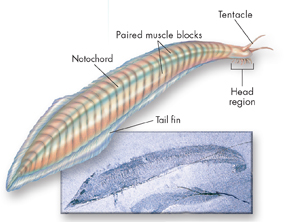26.2 Chordate Evolution and Diversity
 What are the most ancient chordates?
What are the most ancient chordates? What can we learn by studying the cladogram of chordates?
What can we learn by studying the cladogram of chordates?
cartilage
tetrapod
Venn Diagram Construct a Venn diagram comparing and contrasting nonvertebrate chordates and vertebrates.
THINK ABOUT IT At first glance, fishes, amphibians, reptiles, birds, and mammals appear to be very different. Some have feathers, others have fins. Some fly, others swim or crawl. Yet, all are members of the phylum in which we ourselves are classified—phylum Chordata.
Origins of the Chordates
 What are the most ancient chordates?
What are the most ancient chordates?
Chordates are the animals we know best because they are generally large (as animals go), often conspicuous, and strike us as beautiful, impressive, cute, or frightening. Some we keep as pets, others many of us eat as sources of protein. How did all these diverse forms arise?
The Earliest Chordates What were the earliest chordates like?  Embryological studies suggest that the most ancient chordates were related to the ancestors of echinoderms. The rich Cambrian fossil deposits that record invertebrate history also include some early chordate fossils, such as Pikaia (pih KAY uh), which is shown in Figure 26–4. When Pikaia was first discovered, it was thought to be a worm. Then scientists determined that it had a notochord and paired muscles arranged in a series, like those of simple modern chordates. In 1999, fossil beds from later in the Cambrian Period yielded specimens of Myllokunmingia (MY loh kuhn min jee uh), the earliest known vertebrate. These fossils show muscles arranged in a series, traces of fins, sets of feathery gills, a head with paired sense organs, and a skull and skeletal structures likely made of cartilage. Cartilage is a strong connective tissue that is softer and more flexible than bone. It supports all or part of a vertebrate's body. In humans, cartilage supports the nose and external ears.
Embryological studies suggest that the most ancient chordates were related to the ancestors of echinoderms. The rich Cambrian fossil deposits that record invertebrate history also include some early chordate fossils, such as Pikaia (pih KAY uh), which is shown in Figure 26–4. When Pikaia was first discovered, it was thought to be a worm. Then scientists determined that it had a notochord and paired muscles arranged in a series, like those of simple modern chordates. In 1999, fossil beds from later in the Cambrian Period yielded specimens of Myllokunmingia (MY loh kuhn min jee uh), the earliest known vertebrate. These fossils show muscles arranged in a series, traces of fins, sets of feathery gills, a head with paired sense organs, and a skull and skeletal structures likely made of cartilage. Cartilage is a strong connective tissue that is softer and more flexible than bone. It supports all or part of a vertebrate's body. In humans, cartilage supports the nose and external ears.
Modern Chordate Diversity Modern chordates are very diverse, consisting of six groups: the nonvertebrate chordates and the five groups of vertebrates—fishes, amphibians, reptiles, birds, and mammals. About 96 percent of all modern chordate species are vertebrates. Among vertebrates, fishes are the largest group by far. Yet, today's chordate species are only a small fraction of the total number of chordates that have existed over time.  DOL•46–DOL•64
DOL•46–DOL•64

FIGURE 26–4 Pikaia, an Early Chordate Pikaia is the earliest chordate known from the fossil record. Classify Which chordate characteristics did Pikaia possess?

Table of Contents
- Formulas and Equations
- Applying Formulas and Equations
- Mean, Median, and Mode
- Estimation
- Using Measurements in Calculations
- Effects of Measurement Errors
- Accuracy
- Precision
- Comparing Accuracy and Precision
- Significant Figures
- Calculating With Significant Figures
- Scientific Notation
- Calculating With Scientific Notation
- Dimensional Analysis
- Applying Dimensional Analysis




